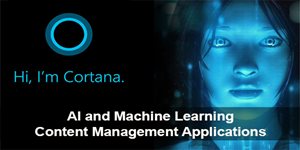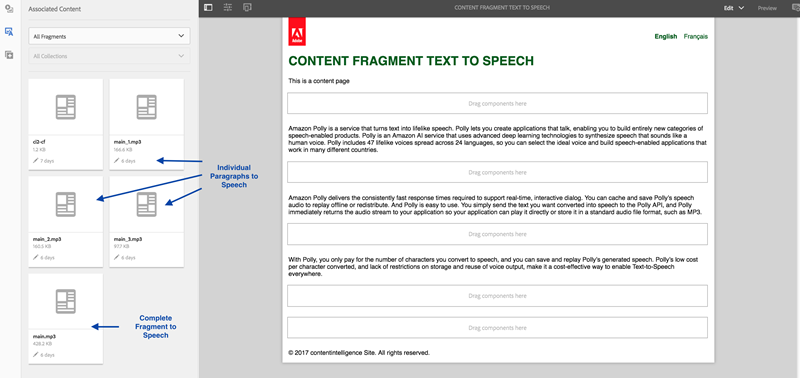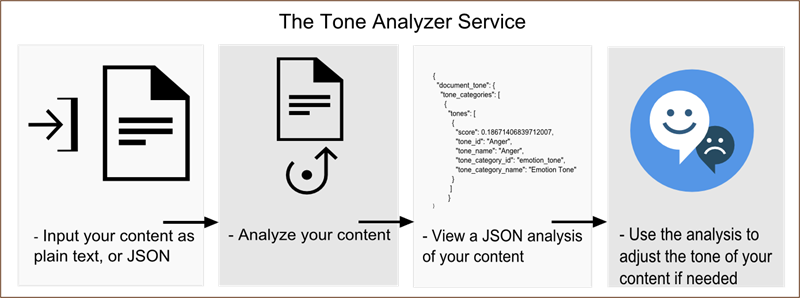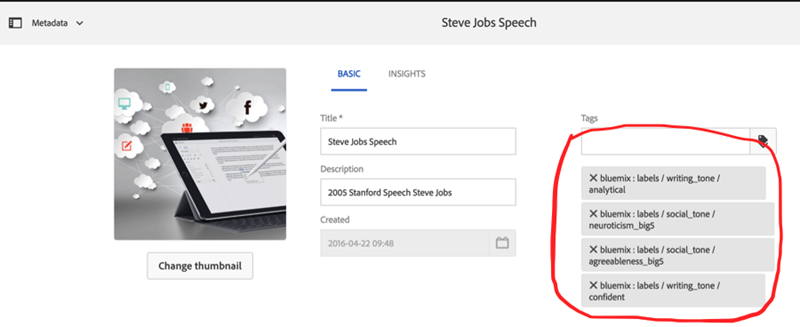The Age of AI: Managing Content Will Never Be the Same
When the "Father of Android" Andy Rubin was betting on the next frontier two years ago by  saying: "There is a point in time — I have no idea when it is — it won't be in the next 10 years, or 20 years — where there is some form of AI, for lack of a better term, that will be the next computing platform,” he was onto something. Today, the AI-powered innovations like driverless vehicles and personal assistants are already stealing the spotlight on a daily basis and making people more productive with their day-to-day tasks. The ripple –through effect of AI didn’t only impact how we interact with the digital world but also it eventually hit the business interactions as well. By narrowing the scope of the digital business world, in this article, we will highlight how AI and machine learning can be applied to content management.
saying: "There is a point in time — I have no idea when it is — it won't be in the next 10 years, or 20 years — where there is some form of AI, for lack of a better term, that will be the next computing platform,” he was onto something. Today, the AI-powered innovations like driverless vehicles and personal assistants are already stealing the spotlight on a daily basis and making people more productive with their day-to-day tasks. The ripple –through effect of AI didn’t only impact how we interact with the digital world but also it eventually hit the business interactions as well. By narrowing the scope of the digital business world, in this article, we will highlight how AI and machine learning can be applied to content management.
When we inject “intelligence” into content management systems, from automating menial tasks to analyzing the tone of each piece of content, the possibilities are endless. As the Salesforce CMO said on the London leg of their World Tour: “Welcome to the age of artificial intelligence, the world will never be the same again and it’s going to happen really quickly.” Therefore, we will be taking a closer look at some cool use cases when the technology is in action.
Text-to-Speech Makes Your Content More Accessible and Immersive
A few weeks ago, here at CMS-Connected, we introduced a new app called Spokata that streams real-time audio content from over 100 verified digital news sources like BBC, Bloomberg, and The Guardian using a combination of its proprietary algorithms and Polly, an Amazon AI text-to-speech service. Although it sounds like a very straight-forward technology innovation, in fact, during my interview with Zack Sherman, CEO and founder of Spokata, he explained how hard it was to build the summarization algorithm that automatically creates short bursts of information from dozens of text sources, which vary in both length and format. “Building our summarization algorithm was a huge challenge -- and one that we are not done solving. In order to automatically create short bursts of information from dozens of text sources, which vary in both length and format, you have to try many different approaches. Before we launched the product we ran that process upwards of 50 million times to get to where we are now. And there is still a lot of room left for improvement,” said Sherman.
The integration between content management systems and text-to-speech technology has lately been garnering a great interest in the industry. Among many benefits, text-to-speech enables digital businesses to make their content more accessible and consumable. Wouldn’t screen readers do the job, you may ask? Well, they do the job but content creators have no control over the quality and tone of the speech. Integrating this technology provides them with the power to maintain brand equity while making it more accessible. Given 75% of people with disabilities, more than 39 Million people use computers today, according to a Microsoft study conducted by Forrester Research, creating an inclusive and accessible society for all in both a real and virtual world and, prohibiting discrimination on the basis of disability has numerous benefits to businesses besides being a social responsibility.
Paddling back to the text-to-speech use cases, one of them in particular, is enriching storytelling. To put this into perspective, the New York Times has recently utilized the technology for publishing one of its compelling stories with voice in a parallax style. For this project, the paper didn’t need to record anything extra or hire a voice actor as it was done with Polly. Martin Jacobs, Group Vice President, Technology at SapientRazorfish, explained how to apply Amazon Polly to Content Fragments in Adobe AEM in his blog post. He uses Content Fragments to create a page as they allow him to create channel-neutral content with (possibly channel-specific) variations. While doing so, he breaks the content fragment into a several paragraphs so Amazon Polly generates a set of audio files such as MP3s broken up by paragraphs. Here’s the visual of the process:

Detecting Emotional, Social, And Language Tones In Written Content
One of the benefits of the advancements in machine learning and artificial intelligence to content management systems is understanding the performance of content. With today’s technology, content creators can analyze how content has come across to readers, which tone resonates with which audience, and so forth. As a content creator and marketer, being able to perform tone analyzing is one of the best features powered by machine learning. As an example of the concept, I can give the IBM Watson Tone Analyzer service as it detects emotional, social, and language tones in written text. The Tone Analyzer provides insight on how the content is coming across to readers, and for each sub-tone, it provides a score between 0 and 1. Some use cases are:

Martin Jacobs and his team also integrated this AI-powered technology with Content Fragments in AEM 6.2. In the implementation, they used IBM Bluemix APIs to perform tone analysis. Then, they ran their implementation against the text of Steve Jobs’ 2005 Stanford commencement speech, from there, the team assigned the results as metadata to the content fragment only if the sub-tone score was 0.75 or higher as below:

Voice-Controlled Content Management Platforms
Following the huge success of the new wave of AI-assisted services like Apple Siri, Microsoft Cortana, Facebook’s M, Alexa-powered Amazon Echo, and Google Home, more and more enterprises have started making bets on conversational systems. A new use case of virtual-assistants has recently made a debut in the content management industry.
Theatro, a provider of intelligent assistant and voice-controlled mobile app platform,  announced a new release to the first ever content management platform for voice, CDM 2.0. This platform allows headquarters and management to create voice messages and automate their delivery to hourly workers in retail, hospitality, and manufacturing. Based on a Forrester study, only 19% of customers believe the store associate is the best resource for information. According to Theatro, the primary reason behind this low number is the lack of associates’ access to the necessary information. In other words, there is a disconnection between employees and management, and it is the drive behind Theatro’s innovation. The vendor claims that the platform enables managers to deliver contextual, mission-critical messages into the ears of their team without store associates having to view a computer terminal or log on to a smartphone app. The platform includes a library of voice messages that can be used over and over again targeting any mix of audiences with promotional messages, important local events, critical training protocols, or even pre-recorded emergency protocol messages for a variety of safety scenarios.
announced a new release to the first ever content management platform for voice, CDM 2.0. This platform allows headquarters and management to create voice messages and automate their delivery to hourly workers in retail, hospitality, and manufacturing. Based on a Forrester study, only 19% of customers believe the store associate is the best resource for information. According to Theatro, the primary reason behind this low number is the lack of associates’ access to the necessary information. In other words, there is a disconnection between employees and management, and it is the drive behind Theatro’s innovation. The vendor claims that the platform enables managers to deliver contextual, mission-critical messages into the ears of their team without store associates having to view a computer terminal or log on to a smartphone app. The platform includes a library of voice messages that can be used over and over again targeting any mix of audiences with promotional messages, important local events, critical training protocols, or even pre-recorded emergency protocol messages for a variety of safety scenarios.
With Theatro’s Content Delivery Manager, headquarters can ensure vital information is communicated across the enterprise, according to the vendor. To sum it up, the technology provides not only convenience but also productivity as well as scalability at the same time.
Cloud-Native Content Services Accelerate the Speed of Innovation
As I indicated in my review of the 2017 ECM market, this year wasn’t short of innovation as almost all major ECM vendors rolled out a set of new AI tools for their content management platforms to help their customers tackle a wide range of enterprise issues from productivity to time-to-market. OpenText, for instance, built its new AI platform by leveraging text mining and semantic analysis to help enterprises orchestrate unstructured and semi-structured information, in areas such as enterprise content management, customer experience, and data discovery. There are so many immediate use cases of the platform in verticals from human resources tasks like employee self-service, recruitment, and retention of fleet management, such as marketing personalization, inventory utilization, and vehicle maintenance. Box, on the other hand, announced a deepening relationship with Microsoft to co-sell its cloud content management platform with Azure to enterprise customers, and add Microsoft's machine learning and artificial intelligence services into its platform. M-Files waded into the foray as it added more AI functionality to its platform through a partnership with ABBYY, an artificial intelligence (AI), text-scanning and optical character recognition software company.
For the same article, I inquired with the ECM veterans on what will drive the market in 2018. One of the most popular trends was cloud-native content services. “We will obviously see continued interest and confidence in shifting ECM and Content Services to the cloud. In the short term, we see customers looking to extend their existing investments with cloud-based content services where cloud is best suited. We see innovation coming in areas where sharing and collaboration is needed with partners and customers outside the firewall, via mobile apps, and built-for-purpose apps that deliver intuitive interfaces into the business process,” said Stephen Ludlow, Senior Director, Enterprise Product Marketing.
Paul Warren, ex-Documentum Engineer and CTO of Dell EMC's Dojo & Cloud Platform Team,  and his team, on the other hand, are working on a new Spring project to help developers build their own cloud-native, scale-out headless content services using the exact same components as the Enterprise Content Management (ECM) vendors such as Documentum and OpenText, without the hassle. In a CMS-Connected interview, he explained: “You can use true Cloud-Native components that allow you to scale your solution way beyond traditional ECMS platforms and operate them with no downtime. You can get very productive indeed. You can build a fully-functioning Content Service with renditions and full-text search with just two Java classes and interfaces! Not only that, you can develop this using modern agile techniques. Spring Content-based Content Services can be fully test-driven and delivered directly to the Customer through automated pipelines. Put together this gives you the ability to innovate faster by getting solutions in front of the Customer quicker and iterating those solutions based on their feedback. This is the essence of modern software development. If you can't do this, you will face an existential threat and, as we all know, the older ECMS lack all of these benefits.”
and his team, on the other hand, are working on a new Spring project to help developers build their own cloud-native, scale-out headless content services using the exact same components as the Enterprise Content Management (ECM) vendors such as Documentum and OpenText, without the hassle. In a CMS-Connected interview, he explained: “You can use true Cloud-Native components that allow you to scale your solution way beyond traditional ECMS platforms and operate them with no downtime. You can get very productive indeed. You can build a fully-functioning Content Service with renditions and full-text search with just two Java classes and interfaces! Not only that, you can develop this using modern agile techniques. Spring Content-based Content Services can be fully test-driven and delivered directly to the Customer through automated pipelines. Put together this gives you the ability to innovate faster by getting solutions in front of the Customer quicker and iterating those solutions based on their feedback. This is the essence of modern software development. If you can't do this, you will face an existential threat and, as we all know, the older ECMS lack all of these benefits.”
What Do Silicon Valley Titans Think of AI Technologies?
According to a recent study, 75% of 1,000 Americans surveyed indicated that those who fail to embrace AI in the workplace will be left behind in their jobs.
Microsoft co-founder Bill Gates seems to share the same belief with those Americans as he  says, “AI is on the verge of making our lives more productive and creative." Boosting productivity in the office wasn’t the only benefit of AI that Gates praised about as he wrote in the forward of Microsoft CEO Satya Nadella's new book "Hit Refresh": "Innovation will improve many other areas of life too." He elaborated on that argument by giving some solid examples: “Digital tracking tools and genetic sequencing are helping us get achingly close to eradicating polio, which would be just the second human disease ever wiped out. In Kenya, Tanzania, and other countries, digital money is letting low-income users save, borrow, and transfer funds like never before. In classrooms across the United States, the personalized-learning software allows students to move at their own pace and zero in on the skills they most need to improve.”
says, “AI is on the verge of making our lives more productive and creative." Boosting productivity in the office wasn’t the only benefit of AI that Gates praised about as he wrote in the forward of Microsoft CEO Satya Nadella's new book "Hit Refresh": "Innovation will improve many other areas of life too." He elaborated on that argument by giving some solid examples: “Digital tracking tools and genetic sequencing are helping us get achingly close to eradicating polio, which would be just the second human disease ever wiped out. In Kenya, Tanzania, and other countries, digital money is letting low-income users save, borrow, and transfer funds like never before. In classrooms across the United States, the personalized-learning software allows students to move at their own pace and zero in on the skills they most need to improve.”
Not all Americans are that cheerful about embracing AI as earlier in July, Elon Musk, the CEO of  SpaceX and Tesla, expressed his concerns with these controversial words: “I have exposure to the most cutting-edge AI, and I think people should be really concerned by it. AI is a fundamental risk to the existence of human civilization." Unlike many technology titans, Musk has longstanding worries about the potential of artificial intelligence. He also warned governments at a meeting of U.S. governors this year, saying: “AI is a rare case where we need to be proactive in regulation instead of reactive because if we’re reactive in AI regulation it’s too late.” He believes that by manipulating information such as doing fake news, spoofing email accounts, and doing fake press releases a war can begin. These statements irked Facebook CEO Mark Zuckerberg as he opposes the spread of fear surrounding the future of artificial intelligence. “AI is going to make our lives better in the future, and doomsday scenarios are "pretty irresponsible," said Zuckerberg in a Facebook Live broadcast. "Whenever I hear people saying AI is going to hurt people in the future, I think yeah, you know, technology can generally always be used for good and bad, and you need to be careful about how you build it and you need to be careful about what you build and how it is going to be used," explained Zuckerberg and scolded: "But people who are arguing for slowing down the process of building AI, I just find that really questionable. I have a hard time wrapping my head around that." Interestingly, Zuckerberg wasn’t the only one who publicly reacted to Musk’s dire warnings. Another Silicon Valley fellow, John Giannandrea, the senior vice president of engineering at Google, who is in charge of the tech giant's AI efforts also stated that “predictions about a dangerous future with artificial intelligence are grossly unhelpful” – without mentioning Musk by name.
SpaceX and Tesla, expressed his concerns with these controversial words: “I have exposure to the most cutting-edge AI, and I think people should be really concerned by it. AI is a fundamental risk to the existence of human civilization." Unlike many technology titans, Musk has longstanding worries about the potential of artificial intelligence. He also warned governments at a meeting of U.S. governors this year, saying: “AI is a rare case where we need to be proactive in regulation instead of reactive because if we’re reactive in AI regulation it’s too late.” He believes that by manipulating information such as doing fake news, spoofing email accounts, and doing fake press releases a war can begin. These statements irked Facebook CEO Mark Zuckerberg as he opposes the spread of fear surrounding the future of artificial intelligence. “AI is going to make our lives better in the future, and doomsday scenarios are "pretty irresponsible," said Zuckerberg in a Facebook Live broadcast. "Whenever I hear people saying AI is going to hurt people in the future, I think yeah, you know, technology can generally always be used for good and bad, and you need to be careful about how you build it and you need to be careful about what you build and how it is going to be used," explained Zuckerberg and scolded: "But people who are arguing for slowing down the process of building AI, I just find that really questionable. I have a hard time wrapping my head around that." Interestingly, Zuckerberg wasn’t the only one who publicly reacted to Musk’s dire warnings. Another Silicon Valley fellow, John Giannandrea, the senior vice president of engineering at Google, who is in charge of the tech giant's AI efforts also stated that “predictions about a dangerous future with artificial intelligence are grossly unhelpful” – without mentioning Musk by name.
Box has successfully capitalized on the transition to cloud and mobile, once and still the major  transformative change, moving forward, it is currently working on new features powered by artificial intelligence. "The first core principle is that we have to grow fast enough to capture this opportunity," stated Box CEO Aaron Levie in late June. Soon enough, the company announced a deepening relationship with Microsoft to co-sell its cloud content management platform with Azure to enterprise customers, and add Microsoft's machine learning and artificial intelligence services into its platform. “We want to be the most open cloud content management platform in the world. We will go wherever the innovation goes,” Jeetu Patel, Box SVP of Platform and Chief Strategy Officer, told in an interview. This is the first time the cloud document-management company will offer customers the option of specifying which public cloud provider will store their Box data, the company said.
transformative change, moving forward, it is currently working on new features powered by artificial intelligence. "The first core principle is that we have to grow fast enough to capture this opportunity," stated Box CEO Aaron Levie in late June. Soon enough, the company announced a deepening relationship with Microsoft to co-sell its cloud content management platform with Azure to enterprise customers, and add Microsoft's machine learning and artificial intelligence services into its platform. “We want to be the most open cloud content management platform in the world. We will go wherever the innovation goes,” Jeetu Patel, Box SVP of Platform and Chief Strategy Officer, told in an interview. This is the first time the cloud document-management company will offer customers the option of specifying which public cloud provider will store their Box data, the company said.
Lastly, a few months ago, I was fortunate enough to interview Riad Hijal, Global VP, Omni- Channel Commerce Solution & Strategy, SAP Hybris on the future of their platform and the e-commerce space. One of the questions asked was about the trends he sees on the horizon, he replied: “The trends of artificial intelligence (AI) and machine learning are increasingly being infused into front-end and back-end operations to ensure consistent, contextualized customer experiences. Aligning with this trend, conversational commerce is taking off as it enables users to streamline the buying process. This is done by quickly responding to any last minute questions that left unanswered could potentially halt or stall the purchase decision. We expect to see an influx of vehicles that enable this such as chatbots, virtual concierges, and digital/virtual assistants. However, these capabilities will only be made possible through integration with a modern, agile, and API-enabled commerce platform such as SAP Hybris Commerce.”
Channel Commerce Solution & Strategy, SAP Hybris on the future of their platform and the e-commerce space. One of the questions asked was about the trends he sees on the horizon, he replied: “The trends of artificial intelligence (AI) and machine learning are increasingly being infused into front-end and back-end operations to ensure consistent, contextualized customer experiences. Aligning with this trend, conversational commerce is taking off as it enables users to streamline the buying process. This is done by quickly responding to any last minute questions that left unanswered could potentially halt or stall the purchase decision. We expect to see an influx of vehicles that enable this such as chatbots, virtual concierges, and digital/virtual assistants. However, these capabilities will only be made possible through integration with a modern, agile, and API-enabled commerce platform such as SAP Hybris Commerce.”
My POV
Although the possibilities are endless when it comes to incorporating artificial intelligence and machine learning into the content creation process, in this article, I tried to highlight a few interesting uses of those technologies that we have just started to see in the content management area. As far as table stakes go, enterprise search, advanced analytics, benchmarking, recommendation engines and personalization have been the most popular areas where machine learning capabilities are injected into.
On the retail side of things, more brands started harnessing the technology to deliver content, increase engagement, and strengthen brand affinity a while ago. Chatbots, for instance, have been around to grasp consumer habits, context, and intent to better predict and provide the content, information or engagement today’s customers are seeking. Now, B2B brands are catching on creating more innovative business cases as well.
I gave this example before in another article of mine but it bears repeating to give a sense of where enterprises are going with this technology. Salesforce CEO Marc Benioff said that they are internally testing Einstein Guidance which provides recommendations based on data as a member of the management team. It is not certain yet if the company will roll out this feature but Benioff already seems very happy to have Einstein in his boardroom as he said: “That ability to consult with Einstein has made me a better CEO.” According to him, the most beneficial aspect of having this type of a technology is that the recommendations come without bias, unlike its human counterparts.
Now, I’m not sure when we will have those robo-CEOs but I’m confident that every single day, organizations are shifting more away from complaining about how AI will put people out of work towards understanding more how to embrace artificial intelligence to get ahead in the industries they serve.

Venus Tamturk
Venus is the Media Reporter for CMS-Connected, with one of her tasks to write thorough articles by creating the most up-to-date and engaging content using B2B digital marketing. She enjoys increasing brand equity and conversion through the strategic use of social media channels and integrated media marketing plans.